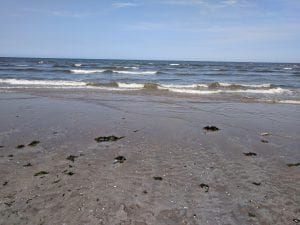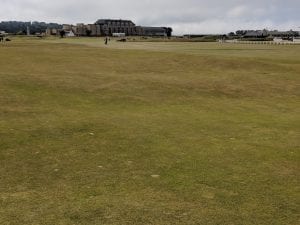I was at one of the best annual conferences – CLAC Annual Conference. This year it was held in Swarthmore College with a reception and a dinner being hosted by Haverford and Bryn Mawr College respectively. They belong to the Tri-College consortium, so it was natural that we were hosted in all three beautiful campuses. I love this conference for the networking opportunities it provides. We are very similar institutions in terms of the number of students, faculty and staff, the services we provide and the issues we face. But still there are considerable variations in what we do and how we are organized, so it is always interesting to exchange notes and learn from each other.
You can read my tweets from the conference here. (more…)

Niest Point Lighthouse Isle of Skye
Scotland turned out to be everything I had heard from my friends who have visited the country before. We were so lucky to have fantastic weather on all the days we stayed there. The temperatures were in the high 70s to low 80s, sunny always. The technology there seemed pretty advanced. When we entered the cab, there were multiple signs saying how the taxis had free WiFi, they accepted credit cards and touch free payments from the phone. When we asked for a taxi that accepts credit card, the airport staff looked at us like “why are you even asking me this question!”
We stayed in a nice hotel in the Old Town near all the usual attractions and walking distance from the University of Edinburgh, where my wife had a conference. We walked to almost all the attractions nearby and burned a few calories, advantages of the big cities! It is a safe place and the fact that there is sunlight from about 4:30 AM till almost 11 PM meant we had a lot more time in the day to explore the city, which we did. One day I walked all the way from where I was staying to Leith, which is a port.
We also took Uber to a couple of places, which was a piece of cake. The Uber drivers were friendly and one of them was telling me how he cannot understand why people drive for Uber part time because it is a pretty poor return on investment. Ok, noted!

I putted that ball in, really!
I drove alone to St Andrews one day to test my luck on getting to play in the Old course. Of course I had made sure that I will be getting a car with automatic transmission, which I did. I am not afraid of driving on the left side, though it takes a bit of time to get adjusted to. It was doubly challenging this time around because I needed to listen to the Google Maps instructions and deal with too many turns in the roundabouts. Long story short, I was pretty close to playing in the Old course, but the woman, who was trying to get me in, finally advised me to play in Jubilee course instead because it was not going to be possible to get me on the Old course. Oh, well, I tried. I played with a gentleman from Arizona in the Jubilee course, who said he has a 10 stroke advantage over me in terms of our handicaps. And I am very proud to say that I did extremely well, given that I walked all 18 holes carrying my clubs and played 8 strokes better than my partner, who was using a rolling cart!

Beach – St Andrews

Mountains and the fog – Isle of Skye
 My wife and I drove for four days. We thoroughly enjoyed the sceneries, the castles, the mountain ranges, the beaches, just the greenery for however long the eyes can see and the friendly people of Scotland. Vegetarian food was a non issue wherever we went. Bed and Breakfast where we stayed were comfortable.
My wife and I drove for four days. We thoroughly enjoyed the sceneries, the castles, the mountain ranges, the beaches, just the greenery for however long the eyes can see and the friendly people of Scotland. Vegetarian food was a non issue wherever we went. Bed and Breakfast where we stayed were comfortable.
Google Maps and Waze were fabulous in directing us. Waze was also cautioning me about the speed limits and speed traps, thank you! They both failed miserably in directing us to gas stations, restaurants and coffee shops. They are simply not accurate in Scotland, especially in smaller towns. In one case, it took us to a Starbucks in Aberdeen at the University there. Unfortunately Starbucks is closed on a Sunday. Not only that, they only open Monday-Friday from 8:30-3:30. Just when I thought Google knew everything, it failed me. At that point, I really wanted a Starbucks coffee and was looking forward to it. We were almost out of gas when we let Inverness to go to Loch Ness. Google said there is a gas stations 9 miles from where we were. When it said you have arrived at your destination, it was right, that we were 9 miles south of Inverness, but no gas station was in sight. We found it the old fashioned way. We asked a human who said, you are better off going back to Inverness, which is what we did, a narrow escape from some unpleasantness.
I am not going to bore you with my travel details, except to say that we drove to the Cairngorms National Park, the Isle of Skye, Speyside, Aberdeen and the Angus Costal route to St Andrews again and back to Edinburgh. The advantages of driving are clear. We got to make so many unplanned stops and changed plans a couple of times.
On the way to Isle of Skye, we were amazed to see an Indian restaurant called “Taste of India” soon after we entered the Isle after crossing a beautiful bridge in Kyle. We wanted to check it out, but were not hungry. It will turn out that many of the small towns we crossed on the way had an Indian restaurant! On the way back, we found it again and stopped for dinner. The parking lot was full and the restaurant was packed! We were seated and were instructed to order everything at the same time because if we wanted to order something later, it will take time. Well, we ordered what we could eat. The food was average. There is a minimum of 10 pounds per person, as in British currency and not weight of food! We finished and gave my credit card for 21.30 pounds. The guy taking it said I can pay 20 pounds in cash rather than charge. Sure, that was a good discount!
We went all the way to the westernmost point in the Isle of Skye – Niest Point Lighthouse. An area with fantastic views of the Atlantic Ocean and cliffs. The drive was a bit unusual in that a long stretch of it is a single lane and you need to negotiate which side is going first. There are spots for one side to park and let the other side go. It was all so civil and well executed. Some of the drives were through small villages and I have the same exact question that I always have – where do they get their groceries, what exactly do they do for a living (most likely farming or fishing), where do they get their petrol and diesel (because I did not come across many gas stations on the way), and where do they buy cars and get them serviced? I was tempted to stop and ask, but then, they may think I am a nut job! If and when I retire, I want to travel differently and stop and ask these questions. They nag me to no end!

One of the places we stopped on the way that was fabulous – Dunnottar Castle Joys of driving.

Carnoustie
We made two unforgettable detours. One is to Dunnottar Castle and another to Carnoustie. The Castle, it turned out, was the best detour we made. Absolutely wonderful setting and views. Carnoustie, of course, is where the next Bristish Open will be played in 3 weeks. We can see all signs of the course getting ready – electronic scoreboards are to be seen at the 18th green. It is a small town with a few tight roads and I wonder how the town will deal with the massive crowds that will descend on them.
We ended our drive by stopping at St Andrews and walking a few holes. That’s right, on most Sundays, the golf course becomes a public park of sorts and the public can just wander around. A few greens are off limits, but other than that, you can wander as you please. I am amazed at the trust placed in the visitors to not do any damage to the course. There were no staff babysitting the visitors!

Walking the St Andrews Old Course
With the exception of Isle of Skye, there was absolutely no issue with cell and data access in Scotland. This time around we decided to sign up for the AT&T deal of $10 a day where all the data consumed is charged to your own existing plan (I have unlimited data!). And guess what, you can also make phone calls to the US. I couldn’t believe it, so I double checked and it was confirmed. We made some phone calls back home and I will find out if this is a deal that holds! This was a blessing because I didn’t have to worry about turning data roaming on and off, configuring Google Photos to not sync when not connected to WiFi etc. In the larger scheme of things, for a travel like this, $10 a day seemed like a no brainer.
Now, back to work to earn a living, so I can go on my next vacation in December…

Green’s View, Sewanee. A beautiful that adjoins the University’s golf course that you can walk to.
I have not been able to post blogs because of my travels during the last couple of weeks in June. First, I was at the annual meeting of Consortium of Liberal Arts Colleges (CLAC) at the University of the South at Sewanee, Tennessee. Then, my wife and I traveled in Scotland for a few days.
I really enjoy the CLAC meetings because it is a fairly small gathering of like minded colleagues from other small liberal arts colleges with plenty of time built in for networking. The keynotes and the presentations I went to were very interesting, including a keynote by the John M. McCardell, JR., Vice Chancellor of the University of the South, who provided a vigorous defense of liberal arts institutions. Of course, he was preaching to the choir and touched on many of the challenges we continue to face.
(more…)
I am sure I have written about this before, so forgive me for the repetition. I landed in this country in September 1978 to do my PhD. Unlike others, I knew exactly what I wanted to work on for my thesis, so I wrote to Prof. David Beveridge at Hunter College, CUNY and he enthusiastically accepted me into his group. So, the day I arrived at Hunter, I had a desk in his lab! I was terribly homesick, hated all the smell and the strange food and despite my fellow Indian grad students trying to cheer me up with things like “How many from India get to walk on the streets on NY and look at the beautiful Empire State Building everyday?”, all I wanted to do was to finish my PhD as fast as I could and get back home.
Then, we were invited to join Prof Beveridge and family for Thanksgiving in their home in Westport, CT. I had no clue about what this was for, but the car ride was an interesting one. It was cold and all the food and drinks looked so alien to me that I hardly touched anything. I remember eating an apple and that’s about it. Regardless, I have a lot to thank for. First and foremost, I want to thank Prof Beveridge, whose support and generosity over the years is clearly a major reason for my professional success. (more…)
Data integration is a fact of life for those of us who are in the information technology business. Since we are yet to invent a single system that does everything for everyone in an enterprise, it is inevitable that we have to support and deal with multiple systems. It is equally true that unless the data from these diverse systems are integrated, we will not be able to understand the data in a coherent fashion. With the proliferation of “best of breed” solutions we have a complicated mess in hand.
Most institutions have a large administrative system like Banner or PeopleSoft that is considered to hold the authoritative data. In addition, for the purpose of reporting, we all have a data warehouse or a data mart into which data from the central systems is inserted typically on a nightly basis. The general premise of this is that the administrative systems were originally designed to take in the transactional data and therefore optimized for that purpose. They were not designed for complex reporting. Combining both of these in one system means a drain in resources and everyone suffers. Modern systems like Workday claims to have designed their system in ways that you can do all activities in one system. When you have multiple systems, generally, the data is integrated with the administrative systems, though in some cases, directly into the data warehouse.
(more…)
I have touched on this topic several times in my postings, but it is always a good reminder as we begin another academic year.
We often see the tension around which technologies will enhance teaching and learning as perceived by the various players. The predominant public discourse on this comes from those connected to education in some fashion or the other, but not from the faculty and the students, . In many higher ed institutions, instructional technologists play the role of both being the resource for the use of existing technologies (such as classroom technologies, learning management systems etc. etc.) but also researching emerging technologies and finding appropriate venues to talk about them to see if the faculty are interested.
There are also institutions where the adoption of technologies seem to be more a top down mandate. I was talking to a friend of mine who is an excellent teacher in a very prestigious institution who was complaining about the pressure to flip classrooms. He flipped and it was a big flopped classroom! (more…)
I do not have an iPhone, sorry! However, there are a couple in my family who do, so I am aware of the apps and advances in that arena. I have been following the Apple Pay technology with a lot of interest. The fact that it is is touch free (“contactless”) is cool in itself, but I am very impressed by the thought that has gone into securing the information from start to finish. The web page titled “Apple Pay security and privacy overview” clearly explains how the technology behind Apple Pay works. I strongly suggest that you read it. In simple terms, a device and credit card specific “secure element” is stored on your iPhone. When you are at a place that accepts this form of payment, using Near Field Communication (NFC) technology, the iPhone and a payment terminal communicate. After you enter your passcode on iPhone, it then transmits a dynamically generated encrypted information that contains the secure element for the credit card you choose, along with a few other information (presumably, the vendor name, the actual charge etc.). This data is received by the bank or the payment network, which then verifies all of this information and accepts the transaction. The key to all of this is that the information is secure, encrypted and is stored on your device as well as the bank. No one else, including Apple and the vendor has access to this information except perhaps in transit, but without the appropriate keys to decrypt, the information in such a short transit is not useful.
Samsung has come up with Samsung Pay, which is very similar, but has one advantage over Apple Pay. It also can communicate with the traditional magstripe terminals. Google is rumored to be revamping its Google Wallet to measure up to these. It is fair to say that most of us are not ready to use these and continue to use traditional methods of using the credit cards in the stores as well as through online. There have been numerous breaches where, because the stores retain our information, they have been stolen. Credit card companies are getting better and alert us of fraud detection, which sometimes can be annoying (because of legit charges) and they tend to arrive at the most inopportune moments, such as when you are just about to embark on a trip. I would love to transition to one of these more secure methods asap. In the meantime…
(more…)
I came back from a fabulous gathering of colleagues from Colgate, Davidson, Hamilton, as well as from Wellesley to discuss some of the next steps in blended learning/MOOC collaboration. What brought us together are two similar Mellon planning grants to see how we can collaborate on this subject. Another glue that binds us is that we are all offering or will soon be offering MOOCs through edX. We came up with specific action items and I will write about that later.
Today, at 2 PM, there is a twitter based discussion being organized by SearchCIO.com on the topic “Is the CIO still relevant?”. An intro to this is available here. And it begins by saying “The traditional CIO is dead. Emerging from the ashes is a new breed of many-sided digital frontiersmen trying to find their place in an evolving enterprise.”. You get the picture.
(more…)
 It is snowing heavily and snow everywhere you turn!
It is snowing heavily and snow everywhere you turn!
While I was at a retreat last week, one of the faculty members was explaining to a trustee how easy it was for her to install and use apps like Uber and Lyft, she has a lot of trouble with software that the College asks her to use, such as Banner and Sakai. I wrote about a similar app that I used in India called Ola cabs. I agreed and gave her some reasons why.
One of the major reasons is that many of the software we use were originally developed very early on and due to a variety of factors, the software companies are simply building on top of older software. The newer “apps” are built using very efficient and modern programming paradigms and have a huge advantage as a result. In other words, if one were to design a brand new learning management system from scratch today, it is likely to be far more in line with the available technologies of today and will look and function very differently. Workday is one such example of an administrative system. It looks very polished, functions very efficiently using technologies such as virtualization in a seamless fashion whereas comparable software like Banner or Peoplesoft have the old look and feel and are monsters in terms of resource requirements. They do use virtualization, but nowhere near to its fullest extent.
(more…)
 After a brief visit to Scripps College , I headed to Orlando to attend the EDUCAUSE annual conference. It was well attended as evidenced by long lines during lunch times. I have never seen such lines before. If you are interested in my tweets during the conference, you can check them out here. If you want to see all tweets with the hashtag #edu14, click here. Though the latter one is long, it is worth reading through some of them or by further filtering based on your interest. I was too tired to tweet after a while because the sessions I went to did not have much for me to tweet and the others were doing a better job.
After a brief visit to Scripps College , I headed to Orlando to attend the EDUCAUSE annual conference. It was well attended as evidenced by long lines during lunch times. I have never seen such lines before. If you are interested in my tweets during the conference, you can check them out here. If you want to see all tweets with the hashtag #edu14, click here. Though the latter one is long, it is worth reading through some of them or by further filtering based on your interest. I was too tired to tweet after a while because the sessions I went to did not have much for me to tweet and the others were doing a better job.
I always look forward to general sessions at EDUCAUSE. This year the first one was by Clayton Christensen on Disruptive Innovation. The entire talk will be available to the public in 90 days here, unless you have a valid EDUCAUSE account, in which case you should be able to listen now. Since I have heard Christensen a few times before, there was not much here for me. Also, he has had recent health issues, and it showed. He himself mentioned his recent stroke, when he was unable to recall a word during the talk. He mentioned how Higher Ed is in a crisis and unless it is disrupted in some serious fashion, the consequences can be dire. Obviously, recent technologies have already disrupted Higher Ed, but the basic methods of teaching, learning and research have not changed and the indirect message that everyone heard is that we, as technologists, can make a difference here. Perhaps! Also, I was not fond of some of the analogies he presented because they may work for corporate America, but not necessarily in Higher Ed. On the other hand, may be that is the disruption that he was referring to.
Chsitensen was also arguing for more open, modular and interoperable “things” in general. We all, especially me, support this wholeheartedly. However, there was a problem. The slide where this appeared, was copyrighted by him!
(more…)










 After a brief visit to
After a brief visit to